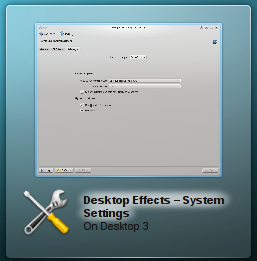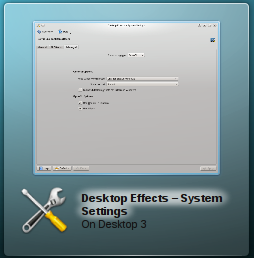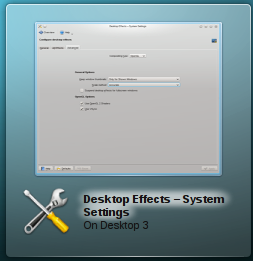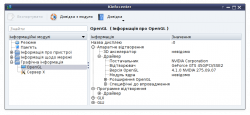Desktop Effects Performance/uk: Difference between revisions
Created page with "Дані щодо використано драйвера можна отримати за допомогою Центру інформації..." |
Created page with "{|class="vertical-centered"
|250px|thumb|left|Дані щодо OpenGL у KInfoCenter||Якщо для пункту відтворюва..." |
||
| Line 14: | Line 14: | ||
{|class="vertical-centered" | {|class="vertical-centered" | ||
|[[Image: | |[[Image:kwin_kinfocenter_opengl_uk.png|250px|thumb|left|Дані щодо OpenGL у KInfoCenter]]||Якщо для пункту відтворювача вказано «Програмне відтворення», драйвер не встановлено. Якщо використано інший драйвер, будь ласка, перевірте, ви використано належний драйвер.<br /><br /> | ||
|} | |} | ||
Revision as of 11:28, 11 December 2011
Швидкодія стільничних ефектів
Швидкодія стільничних ефектів у робочих просторах Плазми KDE здебільшого визначається взаємодією графічного обладнання (графічного процесора), його драйвера і підпрограми композитного відтворення (Kwin). Підпрограма композитного відтворення намагається вибрати найкращі з доступних параметрів для вашого графічного процесора опитуванням драйвера щодо можливостей обладнання. Іноді ваша допомога KWin у визначенні реальних можливостей обладнання може покращити швидкодію.
Вибір належного драйвера
Визначення назви драйвера, який використовується
Важливо, щоб у системі було встановлено і використано належний драйвер. Якщо драйвер не буде встановлено або буде встановлено не той драйвер, стільничні ефекти буде повернуто у режим без апаратного прискорення (XRender).
Дані щодо використано драйвера можна отримати за допомогою Центру інформації. Виберіть пункт і вивчіть дані, показані відповідним модулем. Відповідні дані буде показано у розділі Драйвер, зокрема пункти Постачальник, Відтворювач і Версія OpenGL/ES. Дані буде надано драйвером, можливо вам буде важко у них розібратися.
Доступні драйвери
AMD/ATI
For AMD/ATI hardware two drivers are available: the proprietary fglrx or Catalyst and the free Mesa drivers (known as radeon, r300, r600). With the fglrx driver not all functionality is available and the performance in general seems to be better with the Mesa drivers. The recommendation is to always use Mesa drivers with desktop effects. If you find the information "Mesa" in the OpenGL/ES version, then you are using the free drivers and you do not have to do anything.
The Mesa drivers exist in an older and newer version. You should make sure to use the newer ones which you can identify by the word "Gallium" in the Renderer string.
Intel
Обладнанням Intel використовуються вільні драйвери Mesa. Альтернативних драйверів не існує.
NVIDIA
For NVIDIA hardware two drivers are available: the proprietary NVIDIA driver and the free Mesa drivers (known as nouveau). The free drivers are still under heavy development and are not available on all distributions and for all hardware. In general it is recommended to use the proprietary drivers. You are using the proprietary drivers if it says NVIDIA in the OpenGL/ES version string.
Встановлення драйвера
Спосіб встановлення драйвера залежить від вашого дистрибутива. Будь ласка, зверніться до документації, щоб дізнатися більше.
Версія OpenGL
KWin supports OpenGL 1.x and OpenGL 2.x. By default KWin uses features of OpenGL 2 if they are available. OpenGL 2 allows to use more effects, but requires stronger hardware. It is important to know that even if your driver only supports e.g. OpenGL 1.4 it is possible that KWin uses features of OpenGL 2 which are available through extensions in the driver.
You can find the OpenGL version provided by your driver in the "OpenGL/ES version" string in KInfoCenter as described above. The version is defined by the first two or three digits, e.g. 2.1.
It is not trivial to find out whether KWin uses OpenGL 1 or 2 as this is completely determined at runtime. The best available test is to use the Invert effect which can be enabled in . After enabling the screen should be inverted when using the shortcut Meta + Ctrl + I. If it inverts OpenGL 2 is used, if it does nothing OpenGL 1 is used.
It is possible to force KWin to use OpenGL 1 through and unchecking . This can improve the performance for older hardware. In general it is completely safe to use OpenGL 2 Shaders if the driver reports a version of 3.x (only available with NVIDIA at the time of this writing).
Масштабування мініатюр
The Compositor supports different scaling methods for thumbnails as rendered in the taskbar preview or effects like Present Windows. It is tried to render the thumbnails as accurate as possible which of course requires more resources.
The scaling method can be changed in . The following settings are available:
- Crisp
- Smooth
- Accurate
The table provides an overview of how the thumbnails are rendered with the different settings.
| Overview of how the thumbnails are rendered with the different settings | |
|---|---|
| Crisp: | 
|
| Smooth: | 
|
| Accurate: | 
|
By default Accurate is used. On Intel hardware Accurate is never used and cannot be enabled unless the environment variable KWIN_FORCE_LANCZOS is set to 1.
Switching from Accurate to Smooth can significantly improve the performance of effects like Present Windows.
Загальна швидкість анімації
Animations take some time and the length of an animations is what makes people think that this is a snappy interface or that it lags. This is a very subjective feeling and the difference between too fast and too slow can be milliseconds. It is impossible to have a perfect value for all users.
The global animation duration level can be changed through . It varies from "Extremely slow" to "Instant" which does not render any animations. By changing from "Normal" to "Fast" many users reported having a more snappy interface.
Графічна підсистема Qt
Since 4.7 (Released July 2011) the Compositor can use the Qt graphics system raster instead of native (X11). This is only relevant for rendering the window decorations and is not related to the compositing backends (OpenGL/XRender).
Which graphics system is used depends on the distribution defaults. For the Compositor raster is recommended especially if the NVIDIA driver is used.
Обрамлення вікон
Some Window Decorations perform animations when a window gets activated. This influences the performance of effects if during an animation the active window changes. The performance impact can be reduced by using the graphics system "raster" (see above).
The default window decoration Oxygen provides an option to disable the animations: Checkbox Enable animations. Disabling the animations can improve the performance.
All window decorations which can be downloaded through the Get New Decorations... dialog use such animations, but it is not possible to disable them. If there is an performance impact due to the theme, it is recommended to use a different one. In general the themed decorations are not optimized and provided to look good and not to be fast.
Another area of window decorations which can impact the performance are shadows. Again the default decoration Oxygen provides a setting to disable them in the same configuration dialog as described above in tab "Shadows" and the themed decorations do not provide an option to disable shadows.
Ефект розмивання
The Blur Effect is one of the most expensive effects provided by the Compositor. By default it gets enabled for all hardware except Intel hardware. The performance impact of the blur effect depends on the number of open and translucent windows. Especially translucent widget styles (e.g. Oxygen Translucent) and translucent window decorations (e.g. Aurorae Themes) have an impact on the performance. If such a theme is used and the performance is bad it is recommended to either change the theme or disable the Blur effect.
The performance of the Blur effect can be adjusted through . Moving the slider for strength to "Light" requires less resources while moving it towards "Strong" requires more resources. Since 4.8 (release January 2012) the intermediate rendering results can be kept (default) which improves the performance even with translucent themes.
Додаткові параметри стільничних ефектів
The Compositor provides some advanced settings under . Some of the settings have already been explained. This section focuses on the remaining settings. Changing these settings in general do not improve the performance but make it worse. The Compositor uses the best possible settings.
Тип композитного відтворення
The Compositing type allows choice of the compositing backend, either XRender or OpenGL' By default OpenGL is used which is hardware accelerated. XRender is available even if no OpenGL driver is installed (e.g. virtual machines) and uses mostly the CPU for rendering. Many effects are not available with XRender.
Keep window thumbnails
This has hardly any influence on performance. It is an option to decide how long thumbnails are kept. Best is to not touch this setting.
Suspend desktop effects for fullscreen windows
This setting influences the performance of fullscreen windows such as games. The compositor is suspended as long as there is a fullscreen window. The disadvantage is that it causes flickering when a window appears on top of the fullscreen window (e.g. a context menu) and is too generic. As well on some distributions (e.g. Kubuntu 11.04) the Intel driver causes a crash when closing the fullscreen window.
If the compositor should be disabled while a fullscreen application such as games or video is used it is better to disable compositing either through the shortcut Alt + Shift + F12 or since 4.7 (Released July 2011) through a window specific rule for the window.
Режим OpenGL
Увімкнути апаратне відтворення
Підпрограма композитного відтворення самостійно визначає, чи може бути і чи слід використовувати апаратне відтворення. Зміна типового значення відповідного параметра ймовірно порушить роботу системи.
Використовувати VSync
VSync надає змогу синхронізувати обробку зображення. Якщо у вас немає вагомих причин змінювати типову поведінку, цей пункт має бути позначено. Навіть якщо позначку з пункту не буде знято, підпрограмою показу буде виконано спробу використати частоту кадрів, яка підтримується екраном. Типово використовуватиметься частота кадрів у 60 Гц.
Якщо використовується декілька екранів, важливо знати, що обробка може синхронізуватися лише на одному екрані. Якщо на екранах використовується різна частота кадрів, варто зняти позначку з пункту і встановити частоту кадрів вручну.




